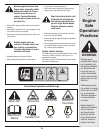
14
8
Engine
Safe
Operation
Practices
Gasoline and its vapors are
extremely flammable and
explosive. Fire or explosion can
cause severe burns or death. If
gasoline is spilled on yourself
or your clothes, wash your skin
and change clothes immediately.
• When adding fuel, turn engine OFF and let engine
cool at least 2 minutes before removing gas cap.
• Fill fuel tank outdoors or in well ventilated area.
• Use only an approved gasoline container.
• Never fill containers inside a vehicle or on a truck or
trailer bed with a plastic liner. Always place contain-
ers on the ground away from your vehicle before
filling.
• If possible, remove gas-powered equipment from the
truck or trailer and refuel it on the ground. If this is
not possible, then refuel such equipment on a trailer
with a portable container, rather than from a gasoline
dispenser nozzle.
• Keep the nozzle in contact with the rim of the fuel
tank or container opening at all times until fueling is
complete. Do not use a nozzle lock-open device.
• Do not overfill fuel tank. Fill tank to approximately
2 cm below lowest portion of neck to allow for fuel
expansion.
• Keep gasoline away from sparks, open flames, pilot
lights, heat, and other ignition sources.
• Never fuel equipment indoors because flammable
vapors will accumulate in the area.
• Extinguish all cigarettes, cigars, pipes, and other
sources of ignition.
• Check fuel line, tank, cap, and fittings frequently for
cracks or leaks. Replace if necessary.
• When starting engine, make sure spark plug, muffler,
fuel cap and air cleaner are in place.
• Do not crank engine with spark plug removed.
• If fuel spills, wait until it evaporates before starting
engine.
• When operating equipment, do not tip engine or
equipment at angle which causes gasoline to spill.
• Do not choke carburetor to stop engine.
• When transporting equipment, transport with fuel tank
EMPTY.
• When storing gasoline or equipment with fuel in tank,
store away from furnaces, stoves, water heaters or
other appliances that have pilot light or other ignition
source because they can ignite gasoline vapors.
Starting engine creates spark-
ing. Sparking can ignite nearby
flammable gases. Explosion and
fire could result.
• If there is a natural or LP gas leakage in area, do not
start engine.
• Do not use pressurized starting fluids because vapors
are flammable.
Engines give off carbon mon-
oxide, an odorless, colorless,
poisonous gas. Breathing carbon
monoxide can cause nausea,
fainting, or death.
• Start and run engine outdoors.
• Do not start or run engine in enclosed area, even if
doors or windows are open.
Unintentional sparking can result
in fire or electric shock. Unin-
tentional start-up can result in
entanglement, traumatic amputa-
tion, or laceration.
• Before peforming adjustments or repairs, disconnect
spark plug wire and keep it away from spark plug.
• When testing for spark, use approved spark plug
tester.
• Do not check for spark with spark plug removed.
WARNING: Gasoline and its vapors are extremely flammable and explosive. Fire or
explosion can cause severe burns or death. If gasoline is spilled on yourself or your
clothes, wash your skin and change clothes immediately.
WARNING
Gasoline and its vapors
are extremely flam-
mable and explosive.
Fire or explosion can
cause severe burns
or death. If gasoline is
spilled on yourself or
your clothes, wash your
skin and change clothes
immediately.
Starting engine creates
sparking. Sparking can
ignite nearby flamma-
ble gases. Explosion
and fire could result.
Unintentional sparking
can result in fire or
electric shock. Unin-
tentional start-up can
result in entanglement,
traumatic amputation,
or laceration.


















